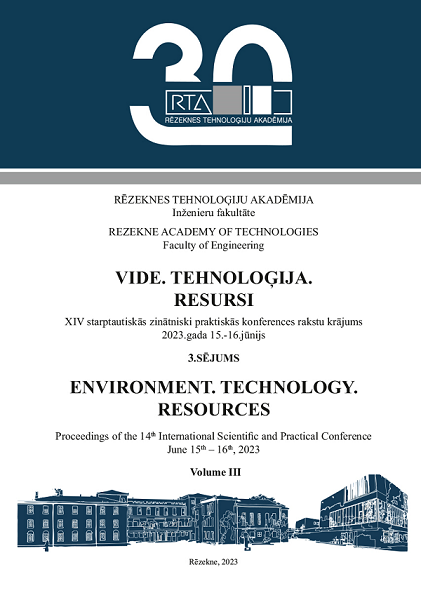RESEARCH ON WORKING BODIES OF HAMMER CRUSHERS EMPLOYING THE FINITE ELEMENT METHOD
DOI:
https://doi.org/10.17770/etr2023vol3.7197Keywords:
finite element method, hammer crusher, disc, strength characteristicsAbstract
The present paper studies the issues of improving the reliability of the working bodies of hammer crushers. This machine is widely used for grinding grain material in animal husbandry and the processing industry. The main wear element of such crushers is the hammers and disks to which they are attached. To study the strength characteristics of these parts, a technique and algorithm for studying the stress-strain state of the hammer crusher disc employing the finite element method (FEM) using computer simulation software products were developed. The mathematical apparatus of finite element method simplifies the model construction where the stress-strain state must be explored. Finite element method provides solutions in the form of stress and deformation fields in almost any cross-section of structural parts. The express analysis module of the APM FEM COMPASS system was used as the software for this work. The implementation of finite element methodwill reduce the metal intensity of the equipment, increase the reliability of its operation and reduce the cost, improve the quality of the feed produced. The results of the study showed that the maximum stresses occur on the surface creating the internal holes in the place of attachment of the disc to the shaft, but the stresses that occur there remain within the normal range.
References
S. Potapova. Klassifikatsia i otsenka izmel’chiteley zerna. MOTROL. Commission of Motorization and Energetics in Agriculture –2013. Vol. 15. No 3. 2013 pp.348-355
V.V. Kirsanov, D.N. Murusydze, V.F. Nekrashevy. Mechanization and animal husbandry technology. Moscow KolosS, 2007. 584 p.
V.I. Trukhachev, I.V. Kapustin, O.H. Angileev, V.I. Hrebennyk. Technologies and technical means in animal husbandry. StGAU Stavropol: AGRUS, 2005. 304 p.
S. Yermakov, K. Mudryk, T. Hutsol. The analysis of stochastic processes in unloadingthe energywillow cuttings from the hopper. Environment. Technology. Resources. Rezekne, Latvia. Vol. III. 2019, pp. 249-252, https://doi:10.17770/etr2019vol3.4159.
V. Ivanyshyn, S. Yermakov , T. Ishchenko. Calculation algorithm for the dynamic coefficient of vibro-viscosity and other properties of energy willow cuttings movement in terms of their unloading from the tanker. Renewable Energy Sources, vol. 154, E3S Web of Conferences. 2020, pp. 04005, https://doi:10.1051/e3sconf/202015404005.
I.V. Demyanushko, I.A. Birger. Calculation of the strength of rotating discs. Moscow: Mashinostroenie, 1978. 247p.
S.V. Kharlamov. Workshop on calculation and design of food production machines and devices. Leningrad: Agropromizdat. Leningrad Department, 1991. -256 p.
V.I. Sokolov. Basics of calculation and design of machines and apparatus for food production: Moscow.: Mashinostroenie, 1983. – 447 p.
M.F. Mykhalev, N.P. Tretyakov, A.I. Mylchenko, V.V. Zobnyn. Calculation and construction of machines and apparatus of chemical production: examples and tasks / Ed. Mykhaleva M. F. Leningrad: Mashinostroenie, 1984.
S.Yermakov, T.Hutsol, V.Devin, S.Oleksiyko, P. Potapskyi. Effectiveness of cognitive digressions in classes of general technical disciplines in institutions of higher education of agro-technical direction.Engineering for rural development. 2022. pp.460-465 https://doi.org/10.22616/ERDev.2022.21.TF154
S. Yermakov, T. Hutsol, S. Glowacki, V. Hulevskyi, V. Pylypenko. Primary Assessment of the Degree of Torrefaction of Biomass Agricultural Crops. Environment. Technologies. Resources. 2021. pp.264-267.https://doi.org/10.17770/etr2021vol1.6597
O.V. Zhurbin, S.D. Chyzhiumov. Analysis of engineering structures by the finite element method: Textbook. Allowance. Komsomolsk-on-Amur: GOUVPO "KnAGTU", 2004. 157p.
R. Gallagher. Finite element method: fundamentals. Moscow: Mir, 1984. 428 p.
O. Zenkevich. Finite element method in technologyMoscow: Mir, 1975. 541 p.
O. Zenkevich, K. Morgan. Finite elements and approximation. Moscow: Mir, 1986. 318 p.
O. Zenkevich, I. Chang. The finite element method in the theory of constructions and mechanics of continuous media. Moscow: Nedra, 1974. 239 p.
V.N. Vasilyeva. Introduction to the theory of the finite element method. Irkutsk, Irkut Publishing House. University, 1986.149p.
A.N. Ivanov. Automated design and calculation of opto-electronic devices in CAD KOMPAS. Educational manual. St. Petersburg: NIU ITMO, 2012. 56 p.
A. Gerasimov. Automation of work in KOMPAS-Grafik (+ CD-ROM). Moscow, BHV-Petersburg, 2010. 608 p.
P. Talalai. Compass-3D V11 with examples (+ DVD-ROM). Moscow, BHV-Petersburg, 2010 616 p.
N.V. Zharkov, M.A. Mineev, R.G. Why. Compass-3D V11. Full manual (+ DVD-ROM). Moscow, Science and Technology, 2010 688 p.
H.S. Pisarenko. Resistance of materials. Kyiv: Higher school Main publishing house, 1979. 696 p.
S.P. Fesik. Reference book on resistance of materials Kyiv: Budivelnyk, 1982. 280 p.
V.I. Feodosyev. Resistance of materials. Moscow: Nauka, 1970. - 544p.



